hey guys, i just came home to find that flys had laid eggs on my dogs food, and thought i'd try my hand at cultivating them for mantis food, im assuming they're just common houseflys so what should i do to make sure they grow up into good food for my mantids? i've put them in a small tub with tiny airholes for the moment obviously still attached to the dogfood, what will i need to do once they turn into maggots etc? any help welcome 
You are using an out of date browser. It may not display this or other websites correctly.
You should upgrade or use an alternative browser.
You should upgrade or use an alternative browser.
keeping houseflys
- Thread starter Thorska
- Start date

Help Support Mantidforum:
This site may earn a commission from merchant affiliate
links, including eBay, Amazon, and others.
The_Asa
Well-known member
Once they turn into maggots, I leave them in sawdust and wait for them to become the pupae. If you want to store the pupae, then just put into the fridge. Take them somewhere warm when you would like them to hatch. That's really pretty much it. I would't recommend breeding them though <_<
The_Asa
Well-known member
Very easy. Once they become flies, you'll want to feed them for nutrition purposes.
its not really that simple as asa has neglected to mention the whole bit between the eggs hatching and the maggots being ready to pupate. while i have never raised maggots with dog food, i have raised them on raw chicken liver. the eggs are layed, and then in a few days you will see a mass of little maggots eating away. they grow surprisngly quickly, a few days after you first see them they will probably be big. i dont really know the properties of dog food, but when i use chicken liver it dries out very quickly. the maggots only eat the "inside" of it, the parts that are still moist, and leave the dry outer layer. i imagine dog food stays moist longer but you will probably know that more than me.that simple? no need to feed or clean etc? great! thanks for the help
when they have eaten and grown enough, they will look for dry places to pupate, and this is when you will see them crawl away from the food/up the container sides. there is not really any need to clean anything as they will eat the decomposing stuff. once you see them crawling away from the food, remove any remaining food. if you want you can check the food, as sometimes they go ahead and pupate right there amongst it without bothering to crawl away from it, though i guess this is because my chicekn liver is dry enough at this point. the sawdust is optional, they dont need it to pupate. however if the container theyre in is not very well ventilated (you said the air holes were tiny), moisture may build up allowing the maggots to climb the container sides with ease, at which point they can cause trouble by escaping out of holes and such. so if you notice this happening, some sawdust would be good, or even just some tissue will do the trick (to absorb excess moisture). once they pupate, like asa says, you can fridge them and take some out every once in a while etc. be prepared for the smell, i hear it is pretty bad! (decomposing chicken liver certainly is

$16.99 ($16.99 / Count)
Josh's Frogs Freshly Started Flightless Drosophila Hydei Fruit Fly Culture
Josh's Frogs

$3.19 ($42.53 / lb)
$6.09 ($81.20 / lb)
Fluker's Gourmet Canned Food for Reptiles, Fish, Birds and Small Animals, Black, Mealworms 1.23 Ounce (Pack of 1)
Amazon.com

$29.99 ($0.15 / Ounce)
TC INSECTS . 200+ XS Red Runner Live Roaches Food for Dart Frogs Praying Mantis Spiders Small Lizard Tropical Fish (1/16-1/4 in)
TC INSECTS

$36.00
Carolina Mantis Egg Hatching Kit - 2 Eggs Fresh for The Season
HeZeXinHaoYunWangLuoXiaoShouGongSi

$12.53
Butterfly Breeding Net, Folding Butterfly Habitat Cage White Butterfly Mesh Cage for Kid Garden Science Education Tool 40x40x60cm
enshishiqiannanwangluoyouxiangongsi

$14.00
$89.85
Praying Mantis Egg Case with Hatching Habitat Cup - 2 Praying Mantids Egg Cases
NaturesGoodGuys

$39.95 ($1.25 / Ounce)
Creation Cultivated 32oz Fruit Fly Culture - Live Feeder Insects for Praying Mantis, Jumping Spiders, Geckos, Lizards, Dart Frogs (Drosophila Hydei Flightless)
Creation Cultivated

$13.99 ($0.44 / Ounce)
$16.99 ($0.53 / Ounce)
Fresh Fruit Fly Culture (Drosophila Hydei) - Praying Mantis Mantid Frog Lizard Food - 32oz Cup
Surmen Legacy

$18.99 ($2.12 / Ounce)
Josh's Frogs Producing Wingless Drosophila Melanogaster Fruit Fly Culture
Josh's Frogs

$13.99 ($223.84 / lb)
Surmen Legacy Freshly Started Wingless Drosophila Melanogaster Fruit Fly Culture
Surmen Legacy
The_Asa
Well-known member
I have raised maggots before and I didn't have any problems that should bear mention...Eggs hatched, maggots ate dogfood, pupated in saw dust, and became flies...I never had to do anything but put the sawdust in. BTW-I tried the chicken liver and I couldn't stand the smell at all :lol:its not really that simple as asa has neglected to mention the whole bit between the eggs hatching and the maggots being ready to pupate. while i have never raised maggots with dog food, i have raised them on raw chicken liver. the eggs are layed, and then in a few days you will see a mass of little maggots eating away. they grow surprisngly quickly, a few days after you first see them they will probably be big. i dont really know the properties of dog food, but when i use chicken liver it dries out very quickly. the maggots only eat the "inside" of it, the parts that are still moist, and leave the dry outer layer. i imagine dog food stays moist longer but you will probably know that more than me. when they have eaten and grown enough, they will look for dry places to pupate, and this is when you will see them crawl away from the food/up the container sides. there is not really any need to clean anything as they will eat the decomposing stuff. once you see them crawling away from the food, remove any remaining food. if you want you can check the food, as sometimes they go ahead and pupate right there amongst it without bothering to crawl away from it, though i guess this is because my chicekn liver is dry enough at this point. the sawdust is optional, they dont need it to pupate. however if the container theyre in is not very well ventilated (you said the air holes were tiny), moisture may build up allowing the maggots to climb the container sides with ease, at which point they can cause trouble by escaping out of holes and such. so if you notice this happening, some sawdust would be good, or even just some tissue will do the trick (to absorb excess moisture). once they pupate, like asa says, you can fridge them and take some out every once in a while etc. be prepared for the smell, i hear it is pretty bad! (decomposing chicken liver certainly is
)
mrblue is right in saying I didn't expand my info enough, sorry, the maggots should remain in the dogfood and then have the sawdust put in. Thanks for correcting me!
Last edited by a moderator:
OGIGA
Dead Leaf Mantis
I don't know if this is a myth, but if you seal tight a container of larvae waiting to pupate and refrigerate them, they'll last longer over all. Larvae do a lot better being refrigerated for weeks compared to pupae. If that is a myth, please speak up!
i think certainly the last part is true. refrigerated pupae (in my experience) tend to have decreased hatch rates the longer they have been in the fridge, while refrigerated larvae do not have this problem. however, my fridge is not very cold so eventually the larvae pupate in the fridge, and if left long enough they even hatch into flies in the fridge.I don't know if this is a myth, but if you seal tight a container of larvae waiting to pupate and refrigerate them, they'll last longer over all. Larvae do a lot better being refrigerated for weeks compared to pupae. If that is a myth, please speak up!
OGIGA
Dead Leaf Mantis
Thanks for clearing that up! It's not a myth after all. 
idolomantis
Well-known member
does catfood works 2?I have raised maggots before and I didn't have any problems that should bear mention...Eggs hatched, maggots ate dogfood, pupated in saw dust, and became flies...I never had to do anything but put the sawdust in. BTW-I tried the chicken liver and I couldn't stand the smell at all :lol: mrblue is right in saying I didn't expand my info enough, sorry, the maggots should remain in the dogfood and then have the sawdust put in. Thanks for correcting me!
Meiji
Well-known member
catfood, monkeyfood, or a chicken mc nugget all work. they aren't picky eaters.does catfood works 2?
idolomantis
Well-known member
monkeyfood?!? you mean bananas?!catfood, monkeyfood, or a chicken mc nugget all work. they aren't picky eaters.
maggots are handy little creatures, as they only eat dead flesh, was used years ago in hospitals to clean wounds like burns as they'd eat all the decaying and damaged flesh and leave the good healthy stuff, so no they're not picky eaters, any dead meat will do, and i assume that you guys don't eat your meat while its still alive (  ) any meat in your fridge or cupboard will do
) any meat in your fridge or cupboard will do
Last edited by a moderator:
ABbuggin
Well-known member
Doctors actually still use maggots today, but only as a last resort.maggots are handy little creatures, as they only eat dead flesh, was used years ago in hospitals to clean wounds like burns as they'd eat all the decaying and damaged flesh and leave the good healthy stuff,
Actually they will propagate in allot of rotten stuff, not just flesh. Recently I started a fly culture myself. It started with a pot of lentil soup that was left out on the stove for a few days and became rancid. When my wife went to clean it she screamed and I had to deal with a writhing pot of maggots. Opportunistically I transfered the rotten soup to a big clear plastic jar, and left the jar open outside. Flies for miles around showed up to deposit their eggs, so many in fact that I actually had no trouble gathering dozens of them from the jar to feed my mantids. as the soup started to become consumed, I added fresh chicken livers to the culture, which attracted even more flies, and I eventually had to put a mesh lid on the jar to keep flies out, but the then continued to lay their eggs on the lid. Once the maggots started to get big I put wood shavings from the chainsaw on top of the culture, and within just a few days the maggots had all pupated. left outside in 90F heat quickly developed the pupae, and in just two days they have all hatched and now I have at least a thousand flies. The mantids are all full and fat, and I am currently working on setting up a second generation culture in a more controlled environment. There were allot of other insects that got in with the culture, including all sorts of little beetles, as well as some little black and white wasp like insects that were running around inside the culture eating the big maggots. I had to evict them lol.
Meiji
Well-known member
Interesting...and more than a little revolting.Actually they will propagate in allot of rotten stuff, not just flesh. Recently I started a fly culture myself. It started with a pot of lentil soup that was left out on the stove for a few days and became rancid. When my wife went to clean it she screamed and I had to deal with a writhing pot of maggots. Opportunistically I transfered the rotten soup to a big clear plastic jar, and left the jar open outside. Flies for miles around showed up to deposit their eggs, so many in fact that I actually had no trouble gathering dozens of them from the jar to feed my mantids. as the soup started to become consumed, I added fresh chicken livers to the culture, which attracted even more flies, and I eventually had to put a mesh lid on the jar to keep flies out, but the then continued to lay their eggs on the lid. Once the maggots started to get big I put wood shavings from the chainsaw on top of the culture, and within just a few days the maggots had all pupated. left outside in 90F heat quickly developed the pupae, and in just two days they have all hatched and now I have at least a thousand flies. The mantids are all full and fat, and I am currently working on setting up a second generation culture in a more controlled environment. There were allot of other insects that got in with the culture, including all sorts of little beetles, as well as some little black and white wasp like insects that were running around inside the culture eating the big maggots. I had to evict them lol.
OGIGA
Dead Leaf Mantis
Nice story. Did any neighbors complain about the smell? Did your wife complain? Did you, yourself, complain??Actually they will propagate in allot of rotten stuff, not just flesh. Recently I started a fly culture myself. It started with a pot of lentil soup that was left out on the stove for a few days and became rancid. When my wife went to clean it she screamed and I had to deal with a writhing pot of maggots. Opportunistically I transfered the rotten soup to a big clear plastic jar, and left the jar open outside. Flies for miles around showed up to deposit their eggs, so many in fact that I actually had no trouble gathering dozens of them from the jar to feed my mantids. as the soup started to become consumed, I added fresh chicken livers to the culture, which attracted even more flies, and I eventually had to put a mesh lid on the jar to keep flies out, but the then continued to lay their eggs on the lid. Once the maggots started to get big I put wood shavings from the chainsaw on top of the culture, and within just a few days the maggots had all pupated. left outside in 90F heat quickly developed the pupae, and in just two days they have all hatched and now I have at least a thousand flies. The mantids are all full and fat, and I am currently working on setting up a second generation culture in a more controlled environment. There were allot of other insects that got in with the culture, including all sorts of little beetles, as well as some little black and white wasp like insects that were running around inside the culture eating the big maggots. I had to evict them lol.
i forgot to ask actually, whats the best food to gut-load flys with for mantids?Very easy. Once they become flies, you'll want to feed them for nutrition purposes.
and also, i know refidgerating slows down fruit flys. but how do i deal with getting the larger, much quicker house flys from the container into the mantids tank without any/too many escapes?
No, actually I moved the whole thing out under the grape arbor about 500 feet from the house. And the nearest neighbor is 1/4 mile away. I was the only one who had to smell them, and I know better than to complain, as nobody would listen anyway lol.
As far as gutloading goes, honey works well as does corn syrup. Other commonly used gutload foods are both powdered and condensed milk, powdered sugar, and sugar water.
here are some shots of the current setup...
The hatching chamber where the culture started:
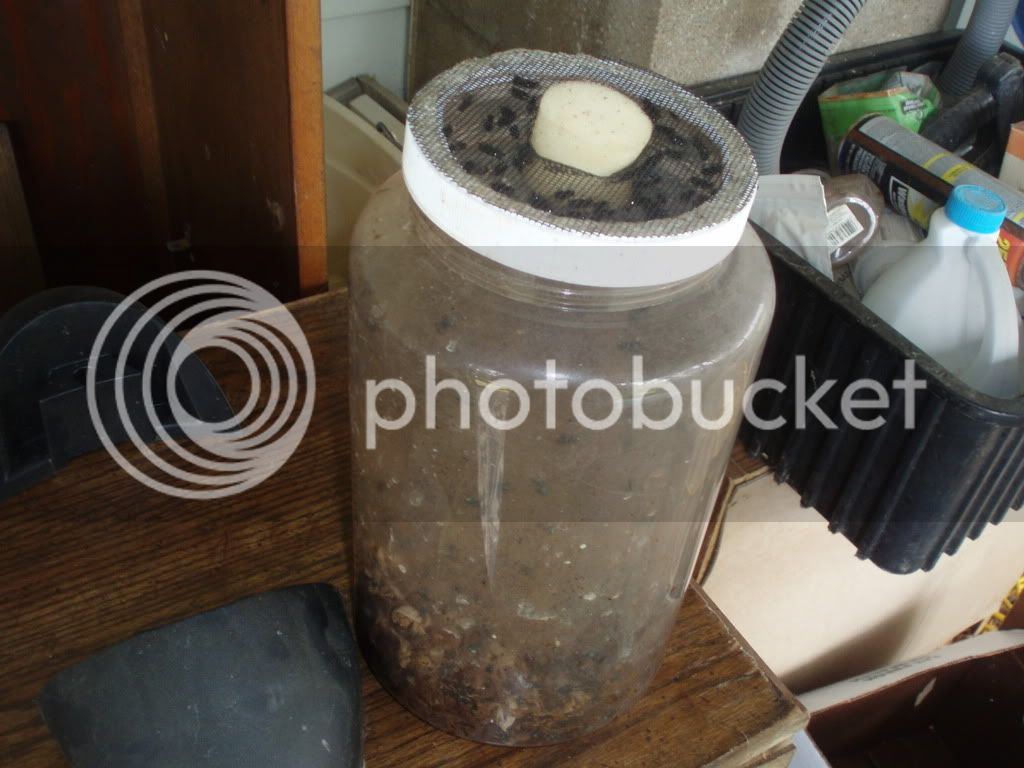
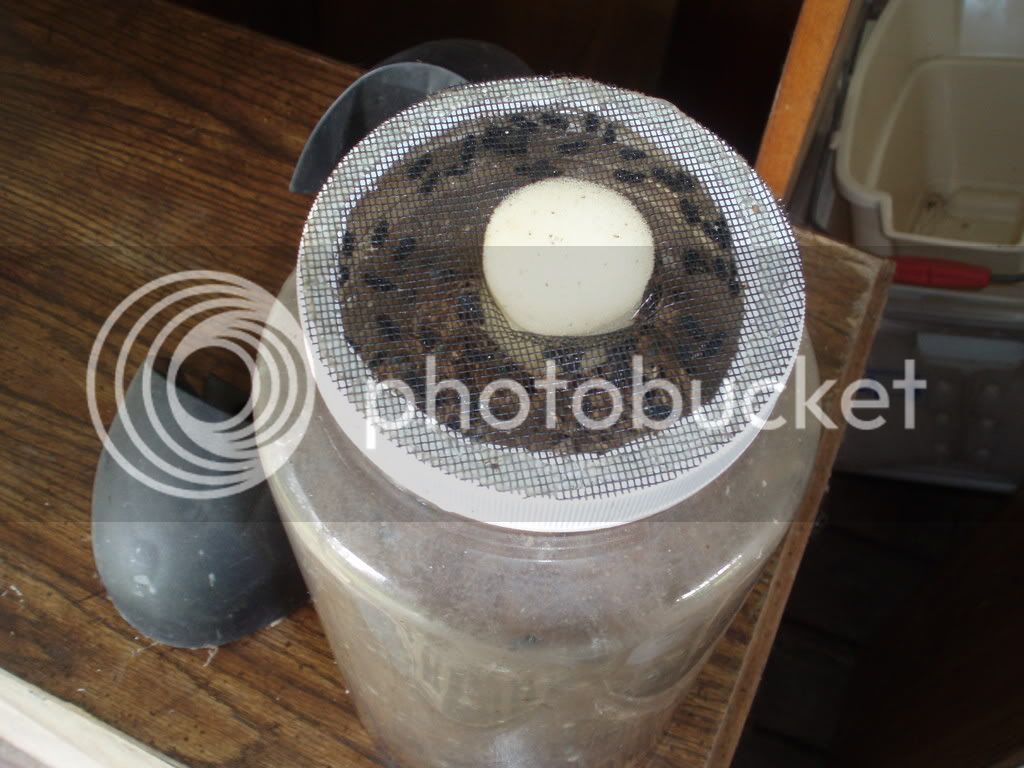
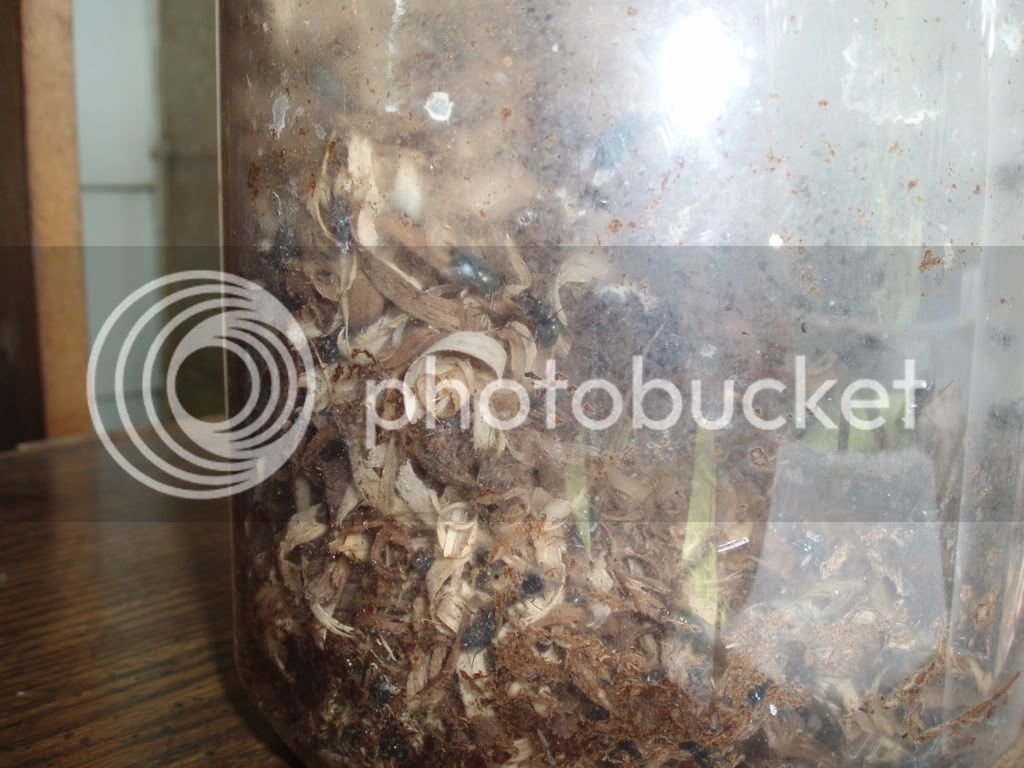
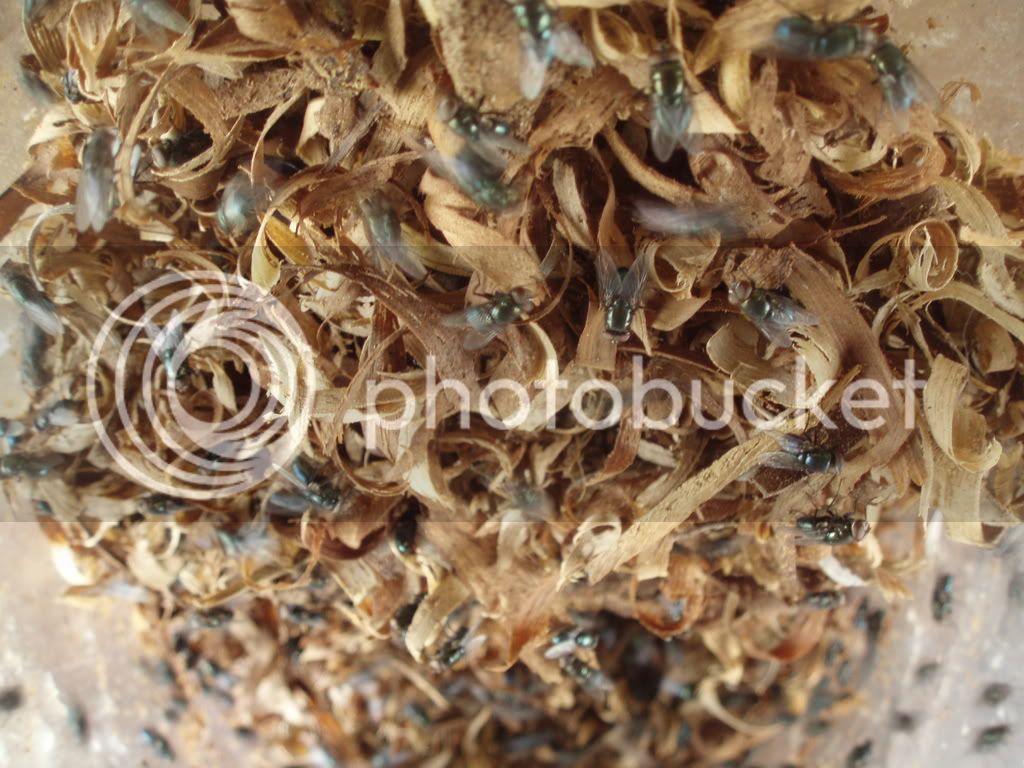
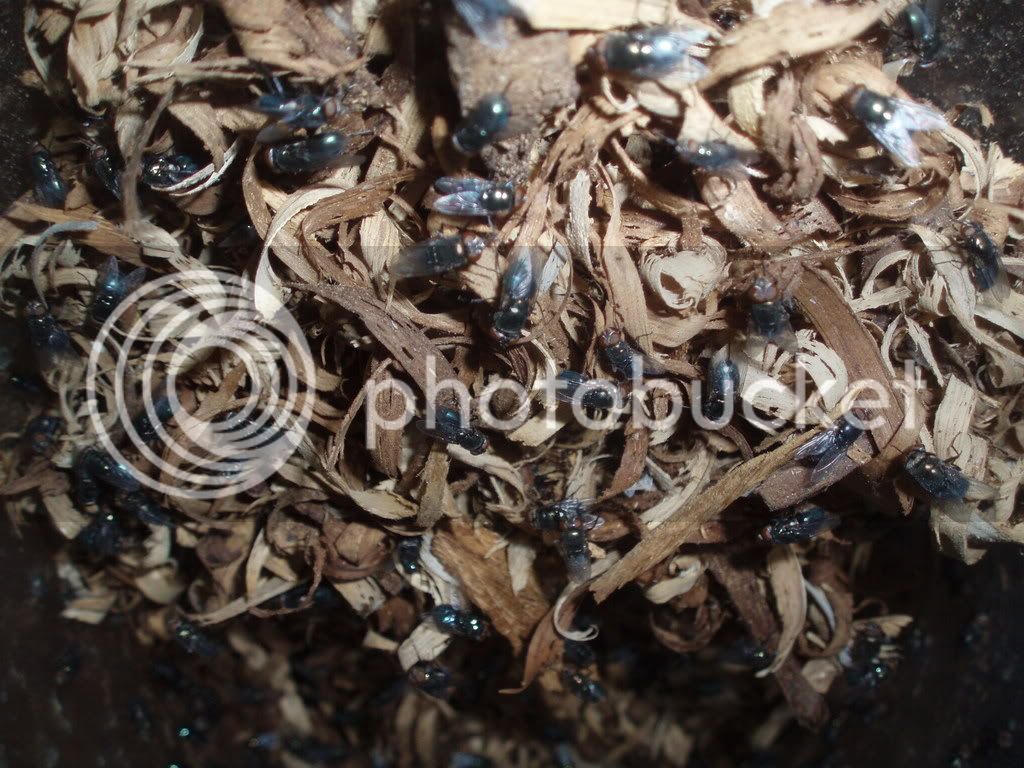
The gut loading chamber where they are fed cornsyrup in a "clean" environment before becoming mantis food:
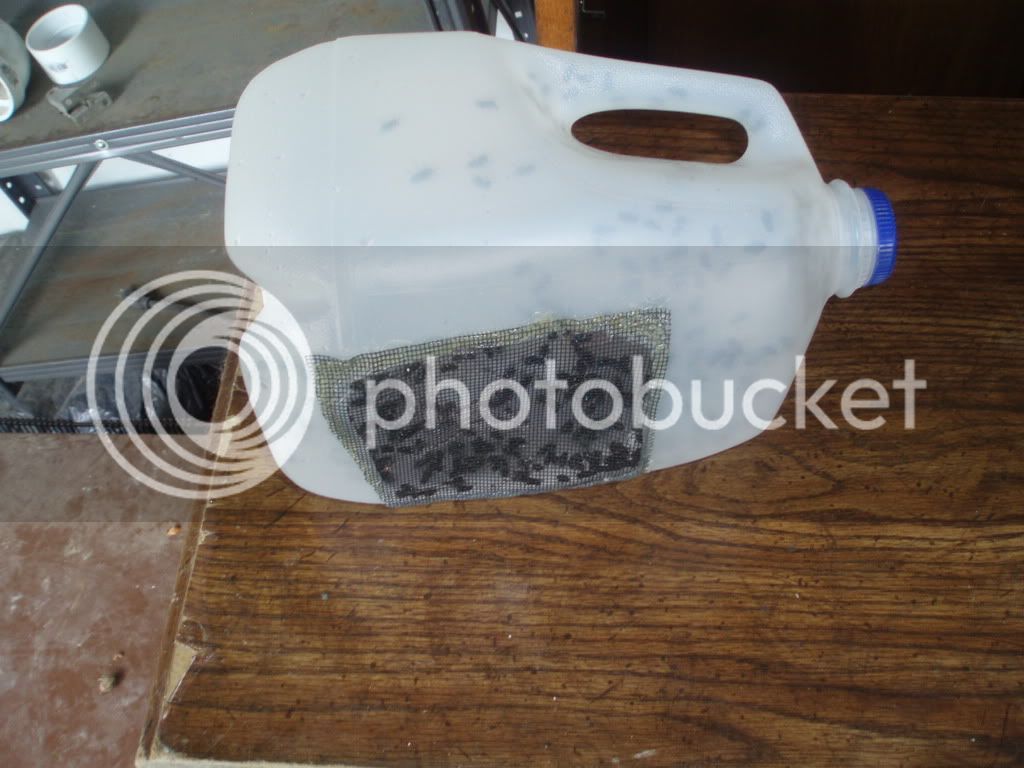
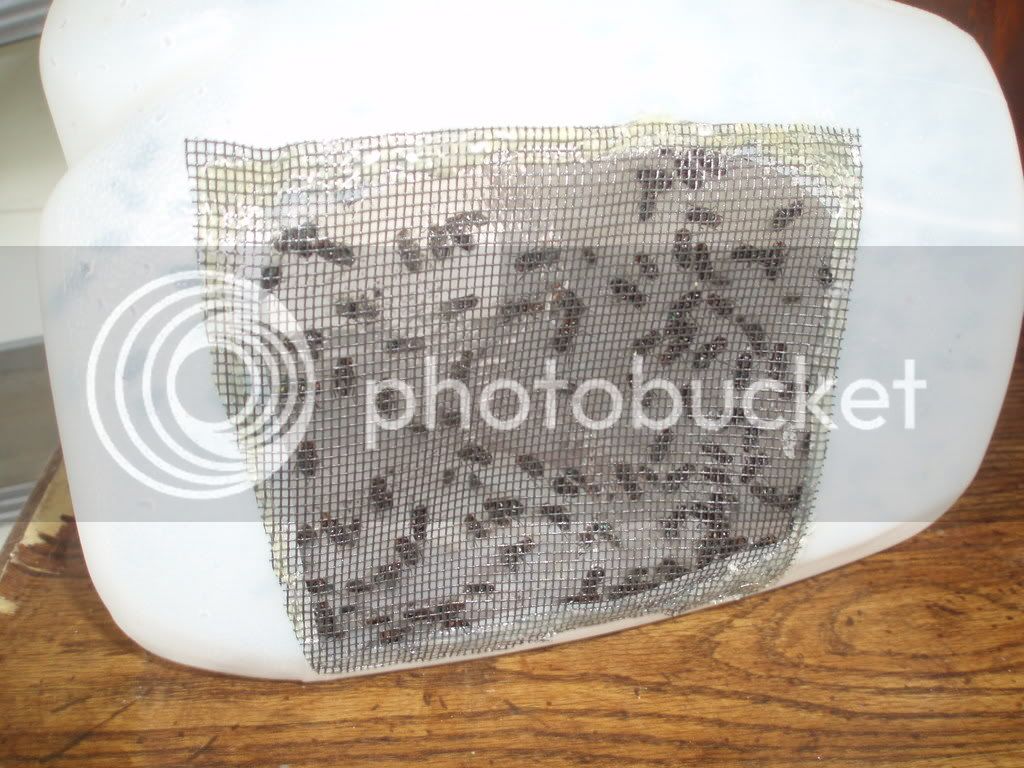
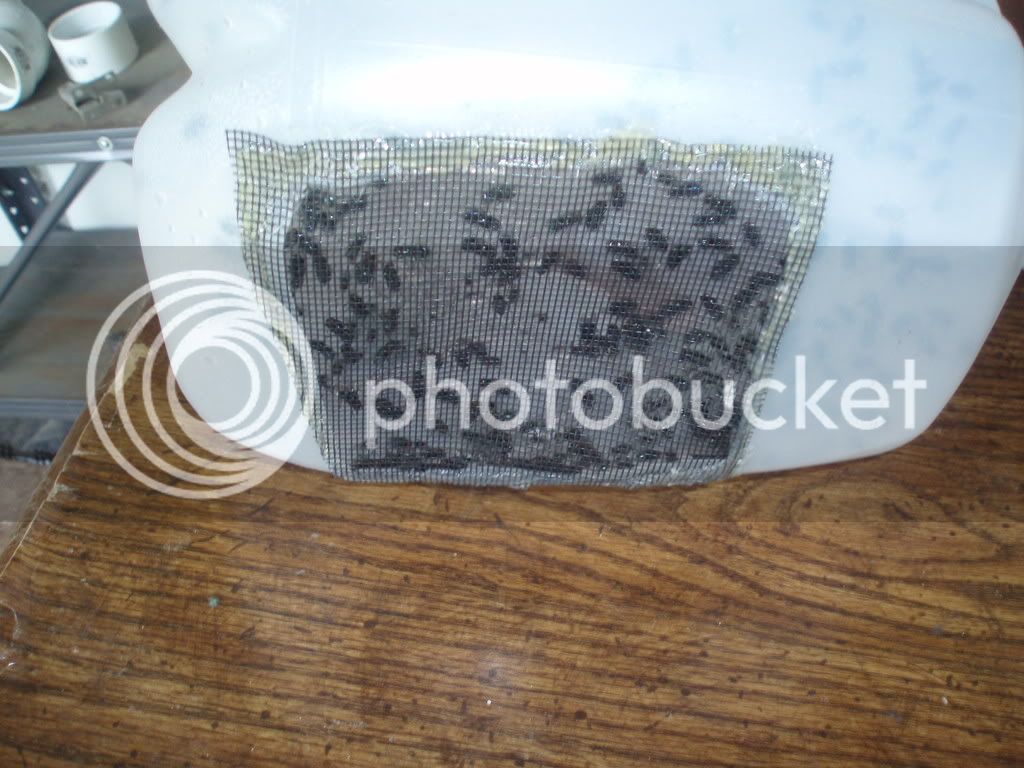
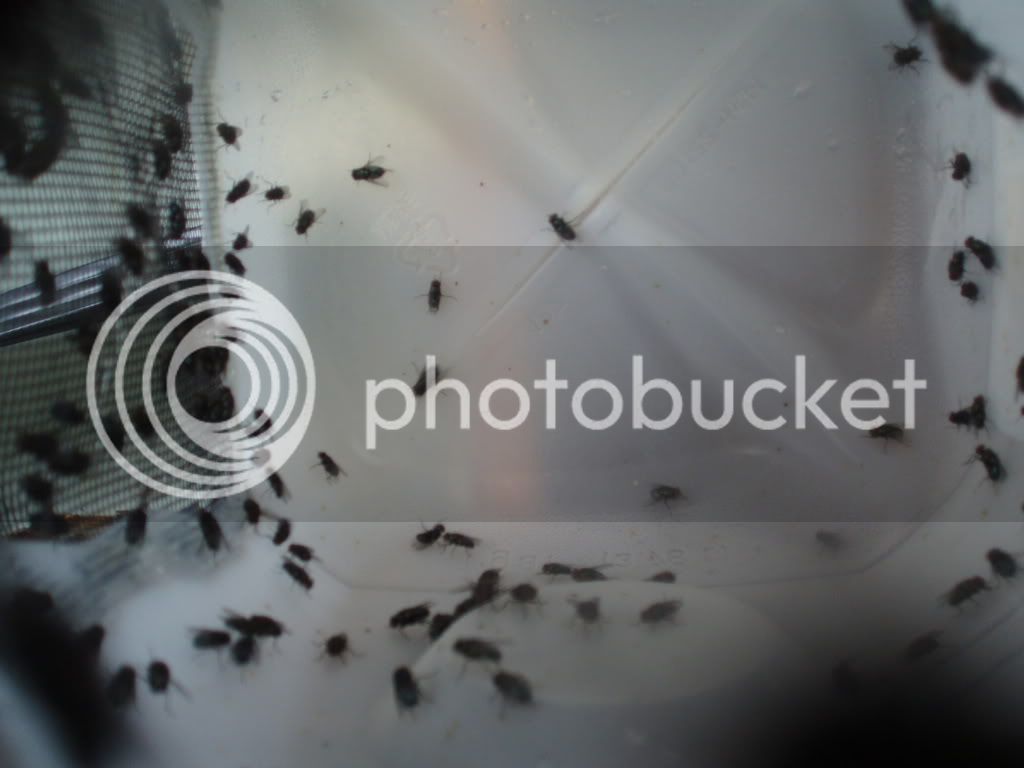
As far as gutloading goes, honey works well as does corn syrup. Other commonly used gutload foods are both powdered and condensed milk, powdered sugar, and sugar water.
here are some shots of the current setup...
The hatching chamber where the culture started:





The gut loading chamber where they are fed cornsyrup in a "clean" environment before becoming mantis food:




































